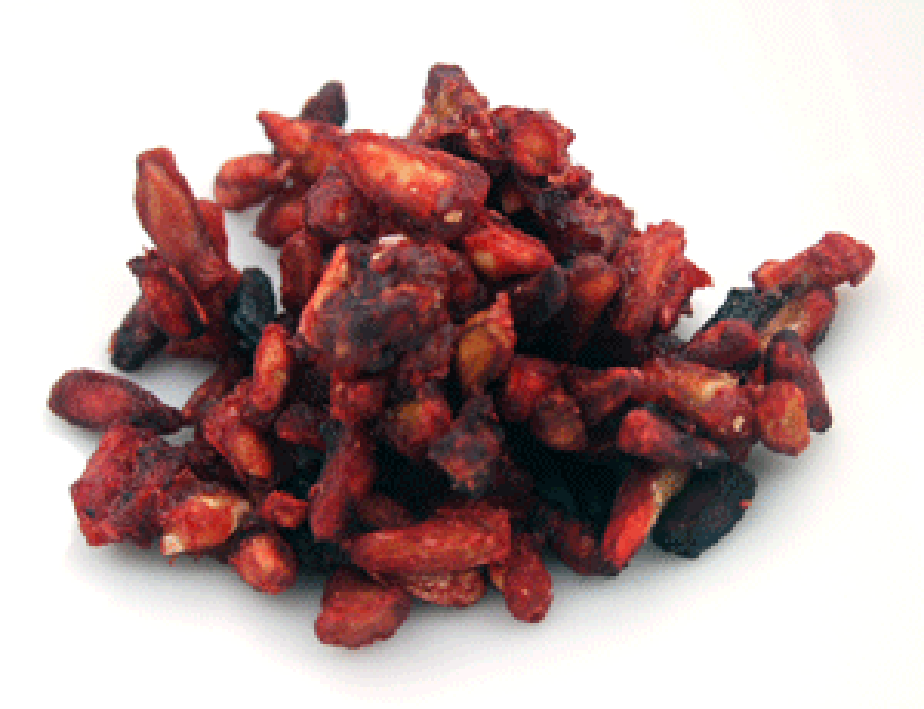FabulousFusionFood's Spice Guide for Anardana Home Page
 Anardana, the dried
seeds of pomegranate
fruit, Punica
granatum.
Anardana, the dried
seeds of pomegranate
fruit, Punica
granatum.
Welcome to the summary page for FabulousFusionFood's Spice guide to Anardana along with all the Anardana containing recipes presented on this site, with 8 recipes in total.
This is a continuation of an entire series of pages that will, I hope, allow my visitors to better navigate this site. As well as displaying recipes by name, country and region of origin I am now planning a whole series of pages where recipes can be located by meal type and main ingredient. This page gives a listing of all the Cornish recipes added to this site.
These recipes, all contain as a major flavouring.
The spice, Anardana, are actually the dried seeds of the pomegranate Punica granatum which is a species of fruit-bearing deciduous shrub or small tree growing to a maximum of about 8m tall and a member of the Lythraceae (loosestrife) family. The pomegranate is believed to have originated in the areas in eastern Iran, but its true native range is not accurately known because of its extensive cultivation. The flowers are bright red, 3cm in diameter, with five petals (often more on cultivated plants). The fruit is between an orange and a grapefruit in size, 7–12cm in diameter with a rounded hexagonal shape, and has thick reddish skin and many seeds. The edible parts are the seeds and the brilliant red seed pulp surrounding them.
The name anardana is derived from the Persian anar (pomegranate) and dana (seeds). They are used most notably Indian and Pakistani cuisine but are sometimes also used instead of pomegranate syrup in Persian and Middle Eastern cuisine. To prepare them the seeds are separated from the flesh before being dried in the sun for between 10–15 days. They are used as an acidifying agent for curries and chutneys. Most anardana is derived from cultivated pomegranates, though seeds of the wild pomegranate daru from the Himalayas are considered the highest-quality source of this spice.
Anardana is also available as dried and ground pomegranate seeds... which is an important ingredient in Pakistani and some Indian curry. This is also a crucial ingredient in Indian Anardana goli.
This is a continuation of an entire series of pages that will, I hope, allow my visitors to better navigate this site. As well as displaying recipes by name, country and region of origin I am now planning a whole series of pages where recipes can be located by meal type and main ingredient. This page gives a listing of all the Cornish recipes added to this site.
These recipes, all contain as a major flavouring.
The spice, Anardana, are actually the dried seeds of the pomegranate Punica granatum which is a species of fruit-bearing deciduous shrub or small tree growing to a maximum of about 8m tall and a member of the Lythraceae (loosestrife) family. The pomegranate is believed to have originated in the areas in eastern Iran, but its true native range is not accurately known because of its extensive cultivation. The flowers are bright red, 3cm in diameter, with five petals (often more on cultivated plants). The fruit is between an orange and a grapefruit in size, 7–12cm in diameter with a rounded hexagonal shape, and has thick reddish skin and many seeds. The edible parts are the seeds and the brilliant red seed pulp surrounding them.
The name anardana is derived from the Persian anar (pomegranate) and dana (seeds). They are used most notably Indian and Pakistani cuisine but are sometimes also used instead of pomegranate syrup in Persian and Middle Eastern cuisine. To prepare them the seeds are separated from the flesh before being dried in the sun for between 10–15 days. They are used as an acidifying agent for curries and chutneys. Most anardana is derived from cultivated pomegranates, though seeds of the wild pomegranate daru from the Himalayas are considered the highest-quality source of this spice.
Anardana is also available as dried and ground pomegranate seeds... which is an important ingredient in Pakistani and some Indian curry. This is also a crucial ingredient in Indian Anardana goli.
The alphabetical list of all Anardana recipes on this site follows, (limited to 100 recipes per page). There are 8 recipes in total:
Page 1 of 1
| Achari Roast Chicken Origin: Pakistan | Anardana Gosht (Lamb Curry with Pomegranate) Origin: India | Chaat Masala Origin: India |
| Aloo Anardana Origin: India | Anardana Jheenga (Pomegranate-flavoured Prawns) Origin: India | Shikanji (Indian Lemonade) Origin: India |
| Anardana goli II Origin: India | Anardana Pakora in Mustard Oil Origin: India |
Page 1 of 1